コラム
落合憲弘
John Sypal
タカザワケンジ
なぎら健壱

For the May entry in my Tokyo Photobook Tour I shared Daido Moriyama’s Lonely Planet-ish guidebook TOKYO (https://photoandculture-tokyo.com/contents.php?i=438). After that article went up I got to thinking about how interesting it would be if more cities around the world had similar photo-travel-guides done by a single photographer like that. Of course, it’s entirely possible that they exist and I don’t know about them- and I’d bet that there’s already such books for New York or Paris. Probably not yet for say, Omaha or Topeka.
The urban tangle of Tokyo, though, has long enjoyed a healthy guidebook industry- both in text and pictures. So, to follow up with Moriyama’s book, I’d like to share some thoughts today on Nobuyoshi Araki’s somewhat similar 2009 guide Tokyo Aruki.
Like Moriyma’s TOKYO, Tokyo Aruki is a portable softcover that’s divided into sections centering on Tokyo’s many distinct neighborhoods. Published by Shinchosha in 2009, it is one of some 360 titles of books under their Tonbo no Hon (Dragonfly Book) series- a series of popular, affordable books that cover nearly every cultural/artistic topic imaginable. (I own two Tonbo books- this Araki one and their Takehisa Yumeji photo special from 1983.)
Similar to his 1999 book Hitomachi- a year-long focus on Tokyo’s Yanesen area- Tokyo Aruki consists of snapshots made monthly meanders with an editor in 2008 and early 2009. The seventeen sections don’t seem to follow any particular directional order but they are strung together chronologically. Indeed, nearly each “chapter” begins by noting the month the walk took place. As the reader accompanines Araki through the pages, the seasons change. Following the flow of life this way is a very Araki way of making a book.
While Tokyo might be thought of as a busy, cold megapolis, Araki’s walks (and photos) are punctuated with smiles- this is the true Tokyo experience. The directness and immediacy and fun found in such photographs are what I enjoy best about Araki’s street work. His visits include Ginza, Yanesen, Mukojima, Tsukudajima, West and East Shinjuku, and many more. In Hongo, the photographer is joined by three young women whom he photographs in trees and on unicycles- in Zoshigaya he stops to have his photo taken at Kafu Nagai's grave. Later, in summer he wades through Shibuya crossing and, on a wet autumn afternoon, enjoys Shimokitazawa’s laid-back backstreets before making an appearance at one of his own exhibitions.

In addition to all the photographs, the pages are punctuated with Araki's cheerful observations on life in Tokyo- and what it means to walk in it. After all, this is something he did for decades. Despite the work he is known for abroad I’m continually discovering pages of photographs of Tokyo he was commissioned for in old issues of magazines like Tokyo-jin or Heibon-Punch. Walking around the city with a camera and an editor or writer was a mainstay of his career in the 80s and 90s.
The afterword goes into these ideas even more- both about the city and his first real walks he made through it with his Pentax 67 after leaving Dentsu in the early 1970s. Those walks resulted in his masterpiece Tokyo, in Autumn. Interestingly, like that book, Tokyo Aruki was also shot with a 6x7 medium format camera- however, in 2009 Araki used a far lighter Mamiya 7II. (In fact, in the pictures of him at work in the afterword you can see two Mamiyas around his neck.)
The book concludes with detailed maps of each area featured- complete with temples and shops AND the actual paths he walked, highlighted. (Phone numbers for the temples and shops featured are shown, just in case you were more of a telephone kind of person than a Google Map one.)
Even though Tokyo has changed so much since this book was published, new copies of Tokyo Aruki can still be found in larger bookshops like Kinokuniya- or cheaply in used shops (or Mericari), usually for no more than 1000 yen. The book is a nice mix of affordability, charm, and now, thirteen years and one pandemic later, one that offers an increasing sense of nostalgia.

先月のコラム「Tokyo Photobook Tour」で、森山大道さんの写真ガイドブック『TOKYO』(https://photoandculture-tokyo.com/contents.php?i=438)を紹介しました。その記事をアップした後、もっと多くの世界の都市に、このような一人の写真家による同様のフォト・トラベル・ガイドがあったら面白いだろうなと考えてみたのです。 もちろん、私が知らないだけでそのような本が存在する可能性は十分にありますし、ニューヨークやパリにはすでにそのような本があるのでしょう。
しかし、東京という都市は、文字と写真の両方で、江戸時代からガイドブック産業が続いています。 そこで、森山さんの本に続いて、5月25日に82歳になった荒木経惟さんの『トーキョウー・アルキ』について、少し語りたいと思います。
『トーキョウー・アルキ』は、森山さんの『TOKYO』と同じく、東京の街並みを中心としたセクションで構成された、ポータブルなソフトカバ一本です。2009年に新潮社から出版された『トーキョウー・アルキ』は、「とんぼの本」というシリーズとして約360タイトルが出版されているうちの一冊です。(ちなみに私は、とんぼの本シリーズは、この荒木さんの本と、1983年刊行の竹久夢二さんの写真特集の2冊を所有しています)。
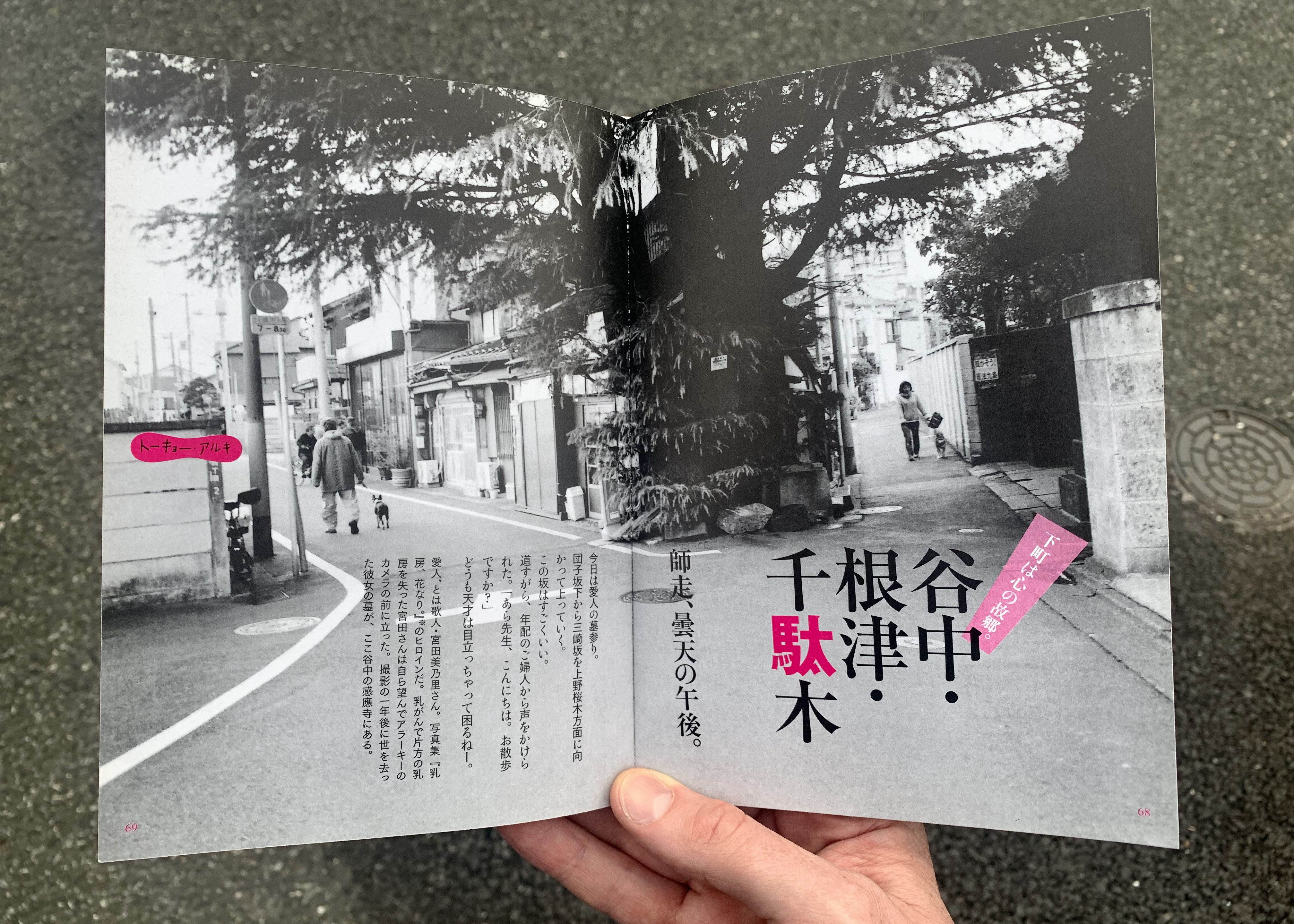
『トーキョウー・アルキ』は、1999年に出版された『人町』(東京・谷中・根津・千駄木に1年間フォーカスした写真集)と同様、2008年から2009年にかけて編集者とともに毎月町をぶらぶらしながら撮影したスナップショットで構成されています。その「アルキ」の数は17回ですが、並びは特に方向性を定めているわけではなく、時系列に連なっています。実際、ほぼすべての「場所チャプター」は、その散歩が行われた月を記しています。読者はページをめくることで季節の移り変わりを感じることができます。このように人生の流れを追うのは、荒木さんらしい本の作り方です。
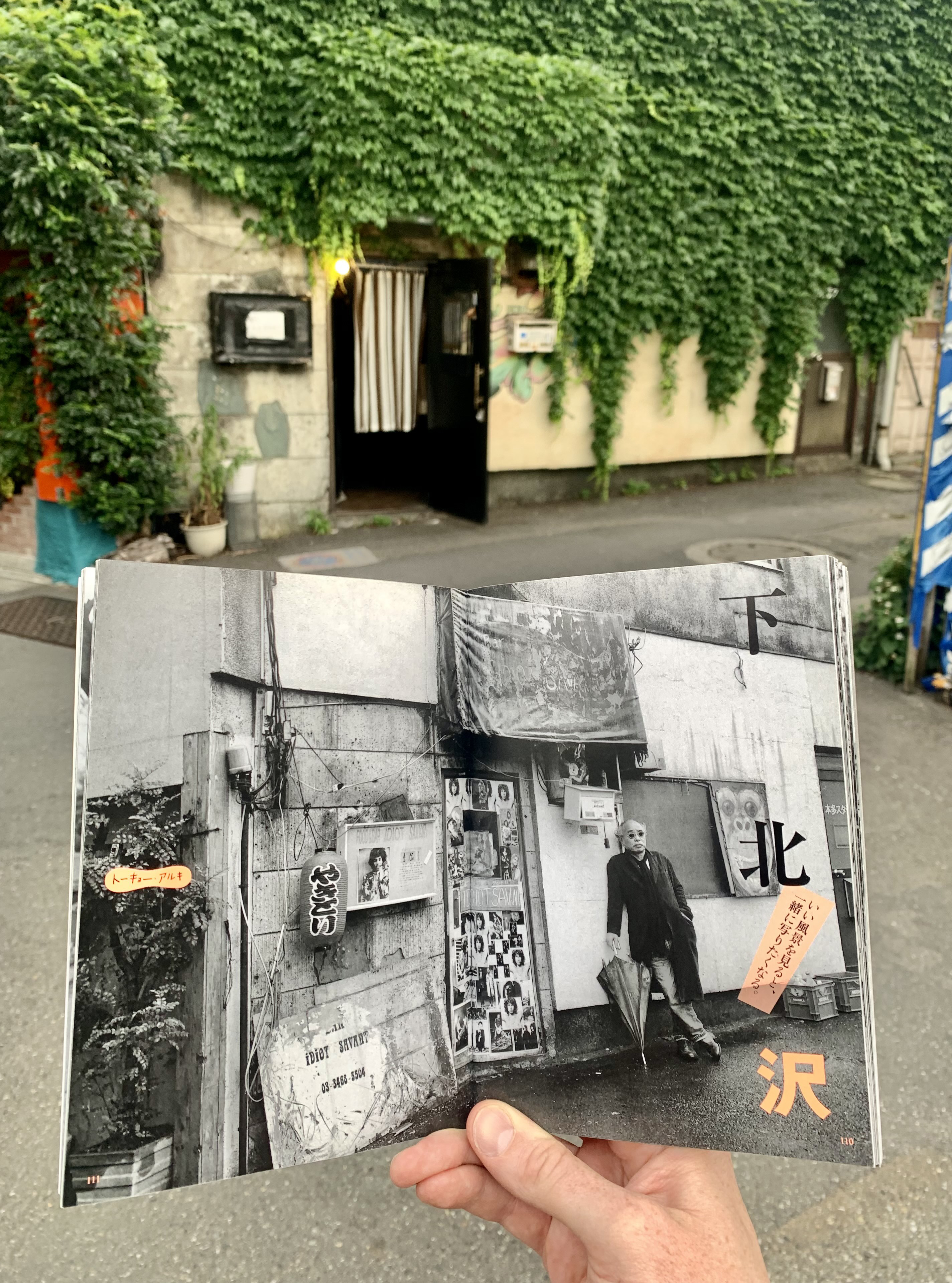
「東京」というメガロポリスは、たまに冷たいイメージがありますが、荒木さんの写真には笑顔があふれていてます。そう、これこそ東京の「本音」だと思います。このような写真に見られる率直さ、即時性、楽しさが、私が荒木さんのストリートワークで最も好きなところです。ページをめくると銀座、谷根千、向島、佃島、西・東新宿などなど巡ります。
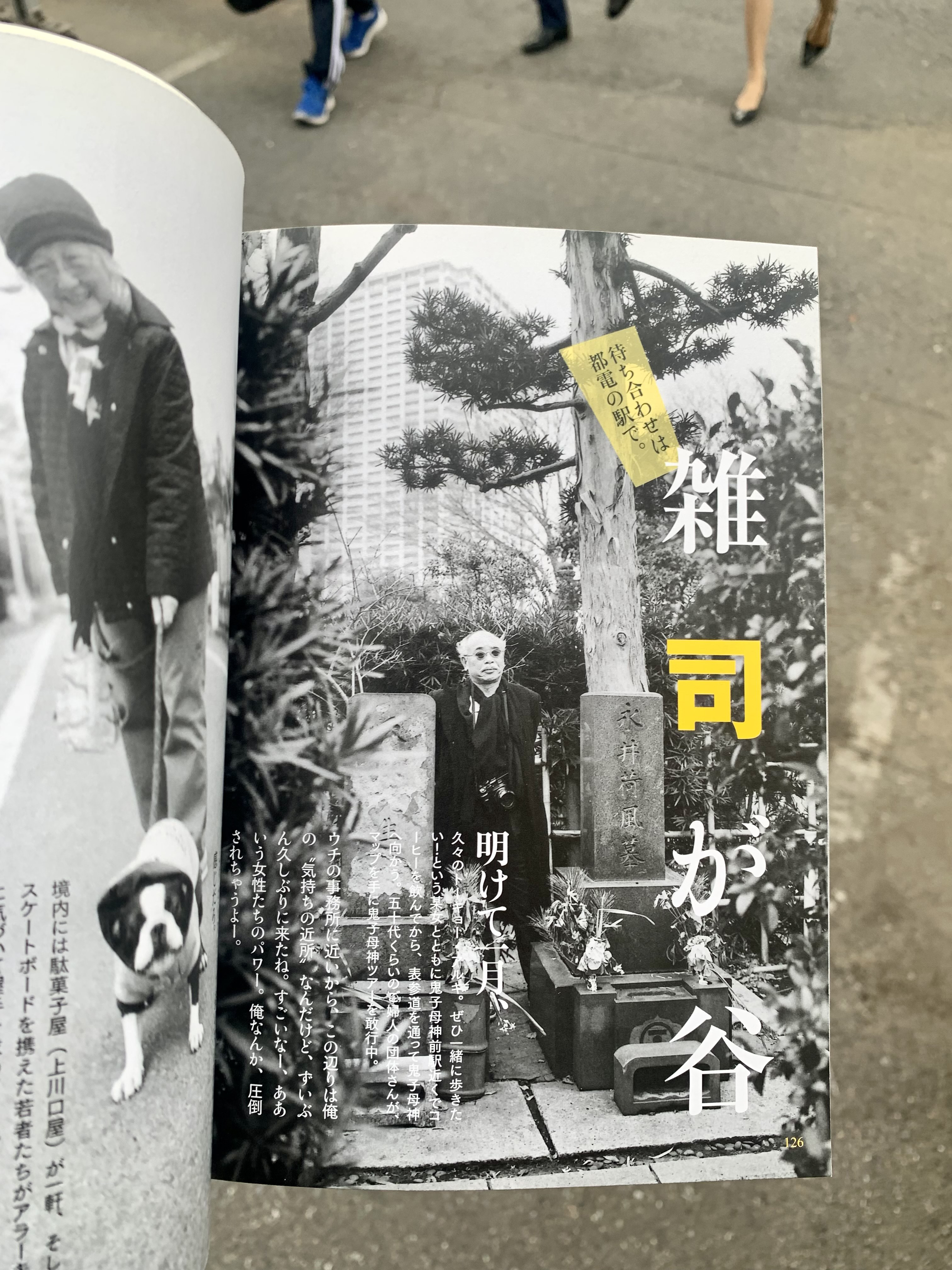
3人の若い女性が木に登ったり一輪車で走るのは本郷。
永井荷風の墓前で記念写真を撮る。
その後、夏には荒木さんがカメラを持って渋谷の交差点を渡る。
秋雨の午後には荒木さんが下北沢ののんびりとした路地裏を楽しみ、自身の展覧会に登場するのです。

写真だけではなくて、東京の生活とその中を歩くことの意味について、荒木さんの明るい観察が描かれています。何しろ、東京を歩くことは彼が何十年も続けてきたことなのです。海外で知られている作品にもかかわらず、昔の『東京人』や『平凡パンチ』といった雑誌から、荒木さんが依頼された「東京の写真」のページを次々と発見しているのです。カメラと編集者やライターと一緒に街を歩くことは、1980年代から90年代にかけてよくあったことだそうです。
あとがきでは、こうした東京を歩く「トーキョー・アルキ」の考えをさらに掘り下げ、1970年代前半に電通を退社後、ペンタックス67で初めて本格的に歩いた街についても述べています。その散歩の結果、彼の名作『秋の東京』が生まれたのです。 興味深いことに、『東京あるき』もこの本と同じく6×7判の中判カメラで撮影されていますが、2009年は軽量なマミヤ7IIとアルキました。

本の最後のページには各エリアの詳細な地図が掲載されており、寺や店、そして彼が実際に歩いた道が強調されています。(Googleマップより電話派という方のために、紹介されているお寺やお店の電話番号も掲載されています。少し不思議でかわいい…)
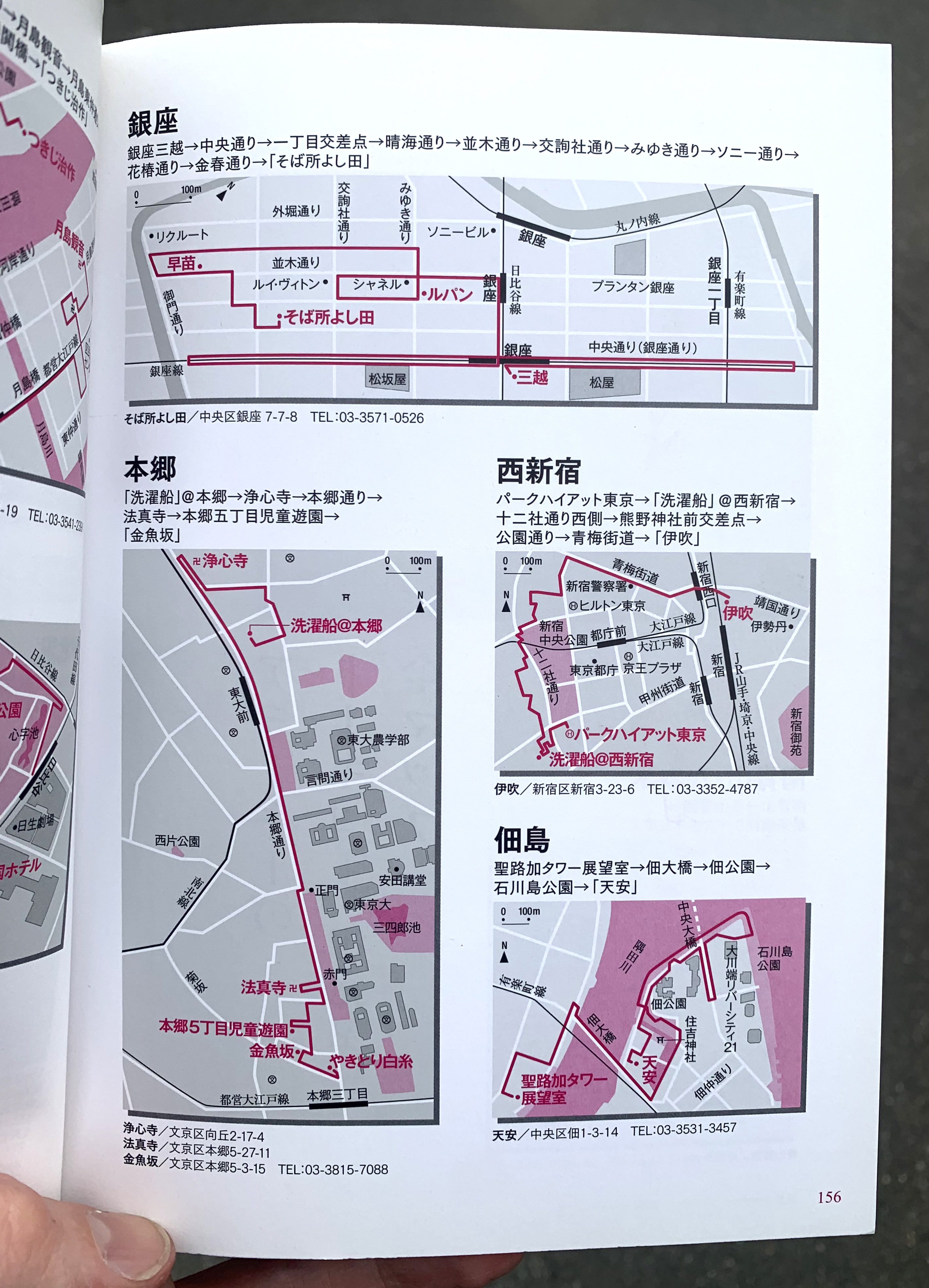
この本が出版されて以来、東京は大きく変わりましたが、『トーキョー・アルキ』の新刊は紀伊国屋などの大型書店や古本屋(またはメルカリ)で1000円以下で簡単に手に入れることができます。
やっぱりこの本は、手頃な価格と魅力、そして13年と1つのパンデミックが経過した今、ますますノスタルジーを感じさせてくれる1冊です。おすすめです。
早くカメラを持ってトーキョーをアルキましょう。
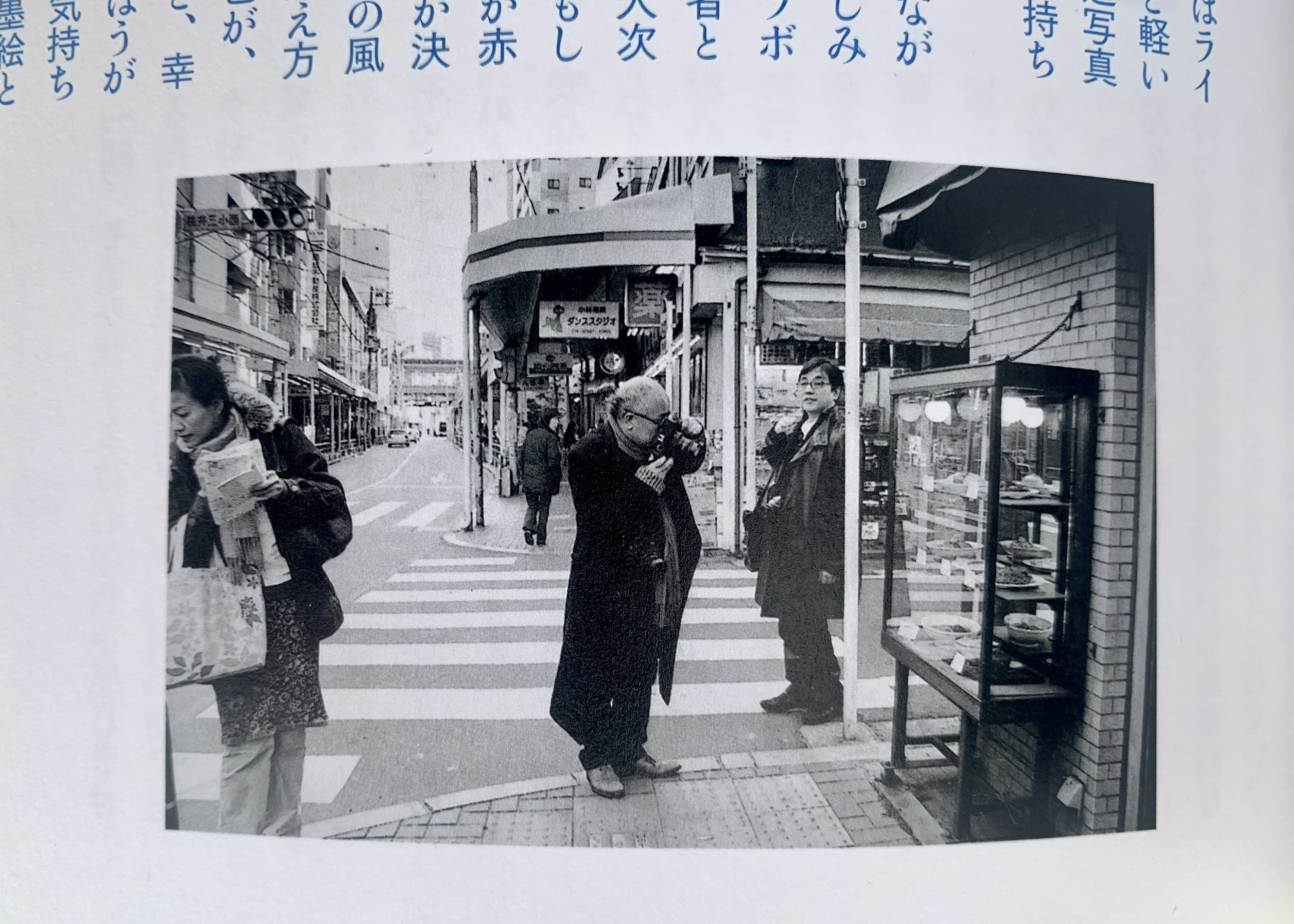
- 荒木経惟『トーキョー・アルキ』
- 新潮社 ・2009年6月25日・159ページ・1,650円(税込)
新潮社ウェブサイト- 高層ビルの谷間で、下町の路地裏で、山の手の住宅街で――アラーキーが歩けば、そこには夢と幸福が待っている。美女との出会い、昭和レトロの再発見、いつの時代も変わらない子供たちの笑顔。「女はすべてすばらしい。街もすべてすばらしい」。散歩と路上写真の極意を名ショットと名言で綴る、かつてない東京案内。
 26 Duets? Duels? Near-overlaps of time and Space across Tokyo. 東京の時間と空間が重なり合う写真集ツアー
2025/04/04
26 Duets? Duels? Near-overlaps of time and Space across Tokyo. 東京の時間と空間が重なり合う写真集ツアー
2025/04/04
 25 Naoki Ishikawa "TOKYO The City Where I Was Born" 石川直樹『東京 ぼくの生まれた街』
2024/01/05
25 Naoki Ishikawa "TOKYO The City Where I Was Born" 石川直樹『東京 ぼくの生まれた街』
2024/01/05
 24 山内道雄 Michio Yamauchi『TOKYO UP CLOSE』
2023/10/20
24 山内道雄 Michio Yamauchi『TOKYO UP CLOSE』
2023/10/20


PCT Membersは、Photo & Culture, Tokyoのウェブ会員制度です。
ご登録いただくと、最新の記事更新情報・ニュースをメールマガジンでお届け、また会員限定の読者プレゼントなども実施します。
今後はさらにサービスの拡充をはかり、より魅力的でお得な内容をご提供していく予定です。
 「Photo & Culture, Tokyo」最新の更新情報や、ニュースなどをお届けメールマガジンのお届け
「Photo & Culture, Tokyo」最新の更新情報や、ニュースなどをお届けメールマガジンのお届け 書籍、写真グッズなど会員限定の読者プレゼントを実施会員限定プレゼント
書籍、写真グッズなど会員限定の読者プレゼントを実施会員限定プレゼント